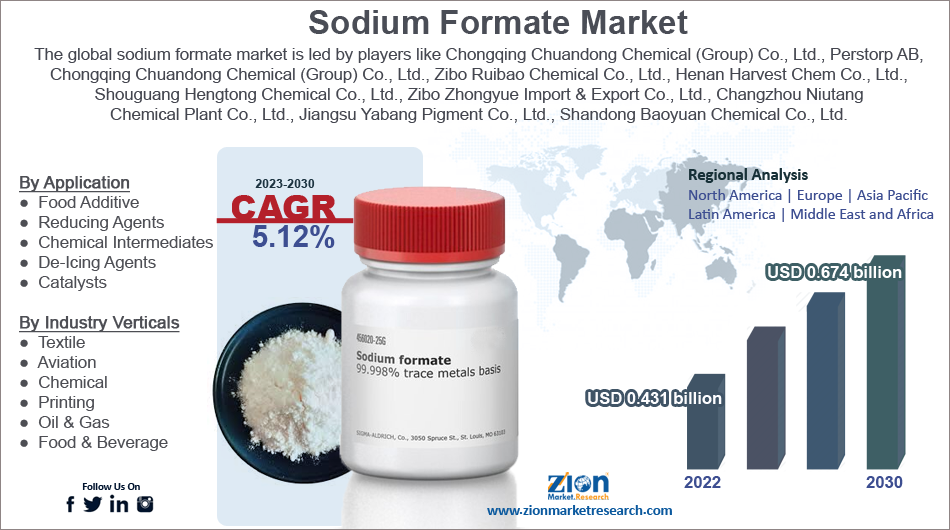Sodium Formate:
Sodium formate is a chemical compound that is classified as a sodium salt of formic acid. Its chemical formula is NaHCOO. The substance in question is a white crystalline powder that exhibits solubility in water and emits a faint scent reminiscent of formic acid. Sodium formate finds widespread application in various industries. It is commonly utilized in the production of formic acid, as a buffering agent in the textile and dyeing sectors, and as a de-icing agent for roads and runways. This versatile compound finds application as a reducing agent in diverse organic reactions, a food preservative, and a drilling fluid additive in the oil and gas sector. Sodium formate finds its applications in various industries such as leather tanning, papermaking, and pharmaceuticals.
Global Sodium formate’s market was worth about $431 million in 2022, and experts expect it will be worth about $674 million by 2030, expanding at a CAGR (compound annual growth rate) of about 5.12% between 2023 and 2030.

Sodium formate finds one of its primary applications in the production of formic acid. Formic acid is an organic acid that has a wide range of applications. It is used in the production of pharmaceuticals, as well as in textile and leather tanning. Additionally, it is utilized as a preservative in the food industry. Sodium formate serves as a precursor in the production of formic acid through reaction with sulfuric acid or hydrochloric acid. The aforementioned reaction yields either formic acid and sodium sulfate or formic acid and sodium chloride, depending on the specific conditions. The formic acid that is produced has potential applications in various fields.
Sodium formate finds application as a buffering agent in the textile and dyeing sectors. Maintaining the pH level of dyeing solutions is crucial in preventing the formation of undesired colors or products. Sodium formate is a valuable substance in the dyeing process of animal fibers, such as wool. Its benefits include safeguarding the fibers from harm and preserving their inherent brightness and gloss.
Sodium formate is commonly utilized as a de-icing agent for both roads and runways, which is a crucial application. Due to its capacity to lower the freezing point of water, it is efficient in melting snow and ice. Sodium formate is a de-icing agent that is known to be less corrosive compared to other alternatives like calcium chloride and sodium chloride. This property makes it a preferred option as it causes less damage to roads and other infrastructure. In addition, this de-icing agent is known to have a lower environmental impact and greater biodegradability compared to alternative options.
Sodium formate finds application as a reducing agent in diverse organic reactions. This compound has demonstrated significant utility in the reduction of carboxylic acids to aldehydes and alcohols, as well as in the reduction of nitro groups to amines. Sodium formate is a preferred mild reducing agent due to its safety and ease of handling, especially when compared to more reactive agents like lithium aluminum hydride.
Sodium formate is commonly utilized as a preservative in the food industry, specifically for meat and poultry products. The inhibition of bacterial and microorganism growth is beneficial in extending the shelf life of these products. Sodium formate finds application as an additive in animal feed to enhance the growth and well-being of livestock.
Sodium formate serves as a drilling fluid additive within the oil and gas sector. Reducing the viscosity of the drilling fluid is beneficial as it enhances the efficiency of the drilling process and mitigates the likelihood of drilling-related accidents. Sodium formate serves as a stabilizer for shale formations, aiding in the prevention of formation collapse while drilling.


Be First to Comment